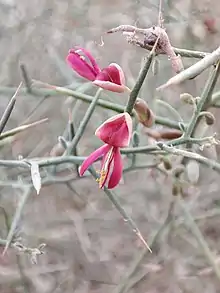| Camelthorn | |
|---|---|
 | |
| A. maurorum flowers | |
| Scientific classification | |
| Kingdom: | |
| (unranked): | |
| (unranked): | |
| (unranked): | |
| Order: | |
| Family: | |
| Genus: | |
| Species: | A. maurorum |
| Binomial name | |
| Alhagi maurorum | |
| Synonyms[1] | |

Alhagi maurorum is a species of legume commonly known, variously, as camelthorn,[1] Alhalgi Psuedahalgi,[1] Caspian manna,[1] and Persian mannaplant.[1] This shrub is native to the region extending from the Mediterranean to Russia, but has been introduced to many other areas of the world, including Australia, southern Africa, and the western United States. The perennial plant grows from a massive rhizome system which may extend over six feet into the ground. New shoots can appear over 20 feet from the parent plant. Above the ground, the plant rarely reaches four feet in height. It is a heavily branched, gray-green thicket with long spines along the branches. It bears small, bright pink to maroon pea flowers and small legume pods, which are brown or reddish and constricted between the seeds. The seeds are mottled brown beans.
Distribution
Alhagi maurorum is indigenous to temperate and tropical Eurasia and the Middle East, in: Afghanistan; Armenia; Azerbaijan; northwest China; Cyprus; northern India; Iran; Iraq; Israel; Jordan; Kazakhstan; Kuwait; Lebanon; Mongolia; Pakistan; Syria; Tajikistan; Turkey; Turkmenistan; Uzbekistan; and Russia (in Ciscaucasia, Dagestan, southern European Russia, and the southern part of the West Siberian Plain).[1]
A. maurorum has become naturalized in Australia and the southwest U.S.[1]
Uses
Alhagi maurorum has been used locally in folk medicine as a treatment for glandular tumors, nasal polyps, and ailments related to the bile ducts.[2] It is used as a medicinal herb for its gastroprotective, diaphoretic, diuretic, expectorant, laxative, antidiarrhoeal and antiseptic properties, and in the treatment of rheumatism and hemorrhoids. The plant is mentioned in the Qur’an as a source of sweet Manna.[3] It has also been used as a sweetener.[1]
In the folk medicine of Iran, Alhagi maurorum decoction has been used for jaundice therapy.[4]
Ecology
Alhagi maurorum is a noxious weed outside its native range. It is a contaminant of alfalfa seed, and grows readily when accidentally introduced to a cultivated field. It has a wide soil tolerance, thriving on saline, sandy, rocky, and dry soils. It does best when growing next to a source of water, such as an irrigation ditch. It is unpalatable to animals and irritating when it invades forage and grazing land.
References
- 1 2 3 4 5 6 7 8 9 The name Alhagi maurorum, replacing Linnaeus' Hedysarum alhagi, was first published in Vorlesungen der Churpfälzischen physicalisch-ökonomischen Gesellschaft 2: 397. 1787. "Alhagi maurorum". Germplasm Resources Information Network. Agricultural Research Service, United States Department of Agriculture. Retrieved November 13, 2011.
- ↑ James A. Duke. "Alhagi maurorum (FABACEAE)". Dr. Duke's Phytochemical and Ethnobotanical Databases. Retrieved December 24, 2017.
- ↑ Tafsir al-Jalalayn. 1505. p. 171. Retrieved 8 October 2020.
- ↑ Tewari D, Mocan A, Parvanov ED, Sah AN, Nabavi SM, Huminiecki L, Ma ZF, Lee YY, Horbańczuk JO, Atanasov AG (Aug 2017). "Ethnopharmacological Approaches for Therapy of Jaundice: Part I". Front Pharmacol. 8: 518. doi:10.3389/fphar.2017.00518. PMC 5559545. PMID 28860989.
{{cite journal}}: CS1 maint: multiple names: authors list (link)
External links
- Jepson Manual Treatment
- USDA Plants Profile
- invasive.org Report
- Photo gallery
- Mohhammad Kazem Gharib Naseri, Seyyed Ali Mard: Gastroprotective effect of alhagi maurorum on experimental gastric ulcer in rats
- Atta AH; et al. "Evaluation of the diuretic effect of Conyza dioscorides and Alhagi maurorum" (PDF). International Journal of Pharmacy and Pharmaceutical Sciences. 2 (Suppl 3): 162–165. Archived from the original (PDF) on 2015-09-24. Retrieved 2011-01-01.
- Atta AH, Mouneir SM (Jun 2004). "Antidiarrhoeal activity of some Egyptian medicinal plant extracts". J Ethnopharmacol. 92 (2–3): 303–309. doi:10.1016/j.jep.2004.03.017. PMID 15138016.
- Plants of the Noble Qur’an
- Plants for a Future database: Camel Thorn